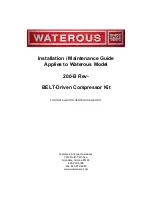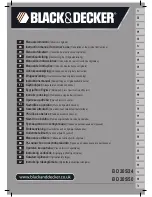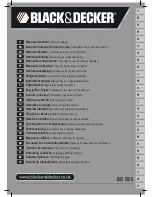
Sperre Air Compressor
Two stage, water cooled
Model: HV1/140A
3. INSTALLATION AND OPERATION
3.1. Installation instructions
Every compressor unit is supplied complete with drawings and specifications showing its dimen-
sions and attachment points. The customer also receives installation instructions giving recom-
mendations for the installation of equipment and piping.
The compressor unit should be installed in a location where the air is not excessively warm.
Warm intake air reduces the capacity of the compressor. Normally, the ambient temperature for
electrical equipment should not exceed 45°C. The compressor unit bedplate should lie plane to
its foundation. After the unit is installed, check the alignment of compressor and motor. The
procedure is shown in Fig. 4, page 32.
Use vernier calipers or inside micrometer calipers to check the distance (W) (Fig. 4). This should
be the same around the whole circumference of the coupling.
Using a micrometer (A), check the radial misalignment between the coupling halves as shown in
Fig. 4. The maximum micrometer reading (A) should be as illustrated in Fig. 4.
Even if the unit has been installed on vibration dampers, an alignment check is to be recom-
mended after installation.
Piping should be so installed that there is no risk of water pockets.
Other equipment should not be installed around the compressor unit in such a way that inspection
and maintenance operations may be hampered.
3.2. Cooling water system
It is of the greatest importance to the operation and life of the compressor that a good and reliable
supply of cooling water is ensured. The quantities of cooling water required are given in Table
T.1, page 35. These specifications apply to both seawater and freshwater cooling.
Whether the compressor is connected to a central cooling system or has its own separate cooling
water pump, it is important to ensure that the cooling water is circulating properly. In this
connection it is not sufficient simply to check that the compressor pressure gauge is registering
cooling water pressure.
If the cooling water feed temperature is too low, increased internal condensation may result. If
this is the case, the cooling water temperature should be increased. If the temperature cannot be
increased by recirculation, condensation can be reduced by reducing the supply of cooling water.
The cylinder block cooling jacket is equipped with a thermometer for the monitoring of cooling
water temperature.
Recommended cooling water temperatures are given in Table T.2, page 35.
3.3. Starting up
Before initial starting up and after long periods out of use, carry out the following operations:
•
Check the oil level.
•
Check that the quality of the oil has not been impaired by water or other foreign matter.
•
Check compressor valves and lubricate the cylinders with oil.
•
Turn over the compressor by hand, with the suction valve relieved by means of the man-
ual valve opener.
•
Check cooling water circulation.
•
Check that the air line cock between the compressor and the air reservoir is open.
•
Open the manual drain cocks on the water trap.
4/26
Summary of Contents for HV1/140A
Page 12: ...Sperre Air Compressor Two stage water cooled Model HV1 140A 6 ILLUSTRATIONS 12 26...
Page 13: ...Sperre Air Compressor Two stage water cooled Model HV1 140A 13 26...
Page 14: ...Sperre Air Compressor Two stage water cooled Model HV1 140A 14 26...
Page 23: ...Sperre Air Compressor Two stage water cooled Model HV1 140A 23 26...
Page 24: ...Sperre Air Compressor Two stage water cooled Model HV1 140A 24 26...
Page 25: ...Sperre Air Compressor Two stage water cooled Model HV1 140A 25 26...
Page 26: ...Sperre Air Compressor Two stage water cooled Model HV1 140A 26 26...





































